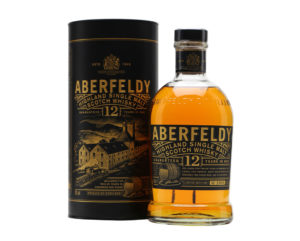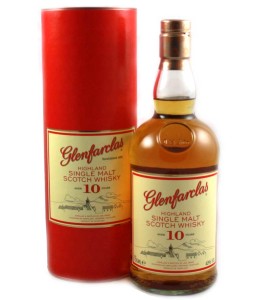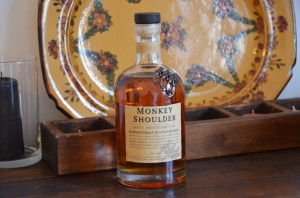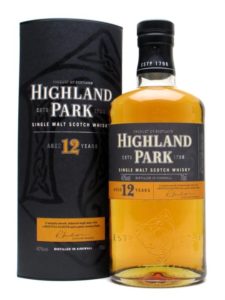Picking A Good Starter Scotch
Choosing The Right Scotch Whisky For A Beginner
By Richard Thomas

(Credit: Dewars)
Introducing a friend to Scotch whisky is far trickier than getting them started on Bourbon. While Scotch has a wide ranging palette of flavors and deep set of styles to work with, that can mean one is just as likely to accidentally turn someone off as on with a casual choice out of the liquor cabinet. For example, some Scotch whiskies lean more into the bitter flavor territory than any American whiskey can, and a segment of the population is genetically predisposed to reject those flavors.
Add to that the lamentable fact that good Scotch is often rather expensive, and getting someone started with Scotch can prove a challenge. Yet given the richness offered by uisce beatha, it’s a thing worth doing. Here is how you do it:
Tips For Picking The Right Dram
The most fundamental rule to follow in choosing a starter Scotch is to know your audience. Peated whiskies, for example, are polarizing within the community of enthusiasts, so using them to introduce novice is unsound in general terms. However, if your friend or audience is a big fan of smoky barbecue, then you can take that as a strong hint that some peat might not go amiss and include a lightly or moderately peated whisky in a starter flight.
“If they’re someone who likes and is interested in extremes, starting them out with an Islay smoke-bomb like Ardbeg or Laphraoig might be a good idea,” says M. Carrie Allan, a spirits writer for The Washington Post. “If they’re someone who usually drinks vodka-tonics, though, I’d look for something more subtle and less in-your-face, [like] a softer Speyside or Highland.”
Any tip can and should be bent or disregarded if it means you can tailor the starter experience to your novice(s).

(Credit: Glenfarclas)
When In Doubt, Avoid No Age Statement Whiskies (NAS): This is not to say you should just plain avoid NAS whiskies, because some are not just very good, but would be outstanding in the role of a starter Scotch. Just don’t gamble on them. NAS expressions generally get an undeserved bad rap, but that is because of some of them actually deserve the bad rap.
“This isn’t a subjective view,” says whisky writer Dominic Roskrow. “You might like fried chicken, I might like roasted chicken, but neither of us likes raw chicken. And some of these NAS whiskies are the equivalent of raw chicken.”
So, if you don’t know that particular NAS expression, don’t risk it.
Avoid Peat Unless You’re Sure The Beginner Will Go For It: As said before, if someone who you know as a fact likes smoky flavors in their food and drink already (strongly smoked bacon or salmon, for example), go for it. Otherwise, steer clear of any hint of peat.
Avoid Very Dry And Peppery Whiskies While You’re At It: While some people might go for smoky whiskies right off the starting line, it’s an even tinier group that will go for the bitterness of a strongly dry and/or peppery whisky.
“Scotches tend in the main to be much drier than, say, Bourbon or Rye,” said Carlo DeVito, editor of the book The New Single Malt. That bitterness is very much an acquired taste, moreso than anything else in the Scotch palette, it’s those flavors that turn some permanently away from the category. Save this particular flavor profile for a later date.
Try To Tailor With Wood Profiles: One of the reasons Scotch is endowed with such varied flavors is because it can draw on casks that have already been used by so many other different drinks industries. The major types are former Bourbon and Sherry casks, but examples of all manner of wines and fortified wines can be found in use for both primary and secondary (“finishing”) maturation. You can use information on the casks used making the whisky to tailor the choice towards what someone likes.

(Credit: Richard Thomas)
“When friends ask me why I enjoy Scotch whiskies I immediately think of the different types of cask that are used to finish off the whiskey,” said actress Patricia Selznick, “because that tells me what fruit notes I can expect.”
However, there is a difference between, say, adding some Sherry flavors with a Sherry cask finish and a genuine Sherry bomb of a whisky. According to Roskrow, “heavily sherried whiskies taste of sherry to the newbie [and] there is no space for the malt to express itself.”
Think Light: Most Scotch whiskies are bottled at between 40 and 46% ABV, compared to American whiskeys where the norm is often between 45 and 50%. There is a reason for that, so don’t use a cask strength whisky or something similarly potent (like Glenfarclas 105) as a starter Scotch. This is not to say one should eschew a good, malty body or some complexity in the whisky, but be mindful to not overpower your beginner(s).
When you start pouring those drams for novices, remember that although the sheer diversity of Scotch whisky means you must beware of a misstep, it also guarantees that there is a Scotch out there for everyone. Or everyone who drinks, at any rate.
Top Seven Scotch Whiskies For Beginners
Aberfedly 12 Year Old: This single malt scores highly as a beginner’s selection, checking off a handful of boxes. It has a good body and a flavor profile sitting squarely in heather-sweet, malty territory. Yet it also has a little sherried fruitiness and just a trace of smoke too. Best of all, Aberfeldy 12 Year Old is one of the biggest bang for your buck single malts in its price range.
Auchentoshan American Oak: This NAS single malt is sometimes derided as a “malt for Bourbon drinkers,” which annoys Scotch snobs, but makes it ideal for bringing Bourboniestas onto the Scotch train. First off, it’s triple distilled, giving the malt whisky a lighter character (more in tune with Ireland than the mainstream of Scotland, in fact). From there, the whisky is matured in first-fill Bourbon casks. A vanilla-infused sweetness lies at the heart of this whisky, perfect for luring reluctant Bourbon drinkers out of their comfort zone.
Copper Dog: This is a very reasonably priced blended/vatted malt, drawing on eight different Speyside distilleries to create a capsule of what the Speyside region is all about. For the beginner that should be good news, since Speyside is essentially the mainstream of Scotch whisky-making. It’s a fruity whisky with nice honey and spice notes, and, best of all, it’s very reasonably priced.

(Credit: Edrington)
Glenfarclas 10: Sherried whisky is both a major sub-section within Scotch, and also rather approachable in its own right. After all, even is Sherry isn’t cool again yet, it is wine and most drinkers know and like (even love) their wine. Glenfarclas is often pointed to as the worthy, sometimes superior alternative to The Macallan, and is known for it’s sherried approach to single malts.
Glenlivet 15 Year Old: “Glenlivet is a great example of the green and yellow fruit of Speyside whisky,” said Roskrow, “but the 15 year old also has a spiciness from maturation in French oak that so this helps show the influence and importance of the oak cask.”
Highland Park 12: Well-balanced and not overly complex, this is a crisp, clean single malt with a nice mix of grassiness, fruitiness and honey sweetness.
Monkey Shoulder: This vatted malt’s balance of quality and cost have made it one of the major choices in go-to Scotch whisky, making it a natural for use as a beginner’s introduction. After all, why not start with something a successful convert will probably stock in their liquor cabinet? It’s a creamy, smooth and easy drinking triple malt, and it’s hard to go wrong with those qualities.




What about Glenmorangie 10 Original? Figure that one would have checked all the boxes on your list.
It does, but for articles like this I draw up the list on the basis of consensus. Glenmorangie 10 didn’t get enough votes to make the Top 7!
I’m interested in trying a scotch for the first time, but I have no idea which one I’d buy. I’m glad you talked about considering what you drink and which flavors you usually enjoy before choosing a scotch. I’ll use your tips when I visit a liquor store later in the week. Thanks.